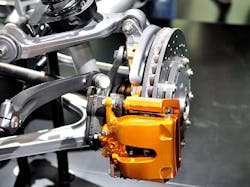What Are the Differences Between Sprung and Unsprung Weight?
“Sprung” and “unsprung weight” are terms that are applied usually to automotive and truck suspension, though they are also applicable to any vehicle that travels on land and uses some form of suspension, such as trailers and construction equipment. (The terms are also interchangeable with the terms “sprung” and “unsprung mass.”)
In simple terms, a vehicle’s sprung weight is supported by springs of one kind of or another (coiled springs, air springs, Belleville springs). Unsprung weight moves up and down with the wheels as they travel over bumps, potholes, and other obstructions. So unsprung weight includes the wheels, tires, brake assemblies, differential, solid drive axles, hub motors, and anything directly connected to the wheels is unsprung mass. This still leaves the majority of the vehicle’s components weight as sprung weight—the chassis, motor, transmission, body, and interior, as well as the passengers and cargo.
There are also semi-sprung parts (also called partly sprung or hybrid weight). These parts are usually attached to the wheel on one end and to a sprung component on the other. The springs themselves, for example, connect the wheel to the body. The half shaft going from the transmission to a wheel is another semi-sprung part. The list also includes shock absorbers and struts, control arms and other suspension parts, half shafts and other drive shafts, and some steering components.
Sprung weight is shielded from the shocks and vibrations that the wheels experience as they travel over every bump and pothole. This makes for a more comfortable ride and protects the sprung components from destructive and life-shortening shocks and vibrations. Conversely, unsprung weight must be designed to be tough enough to survive the constant shocks and vibrations, which can be difficult for complex parts such as hub motors and wireless pressure sensors.
In general, it’s best to have a high ratio of sprung-to-unsprung weight. A higher proportion of sprung weight can then push down on the wheels and tires with more force, keeping them in contact with the pavement or whatever surface they are traveling across. Maintaining contact with the roadway improves handling and traction, and this becomes more of an issue for off-roading and traveling over rough roads.
So as a rule, designers try to minimize unsprung weight to improve handling and steering. That’s why hot-rodders and auto enthusiasts invest money in alloy wheels —to reduce the unsprung weight and make steering more precise. Lighter wheels and tires also mean it takes less energy to spin them or bring them to a stop, but this has nothing to do with sprung and unsprung weight.
The difference between rotating mass and non-rotating mass is somewhat related, especially in terms of performance. Physics dictates that it is more difficult to accelerate rotating mass than non-rotating mass. This means those lighter tires and wheels also take less force to accelerate them forward.
Looking for parts? Go to SourceESB.

